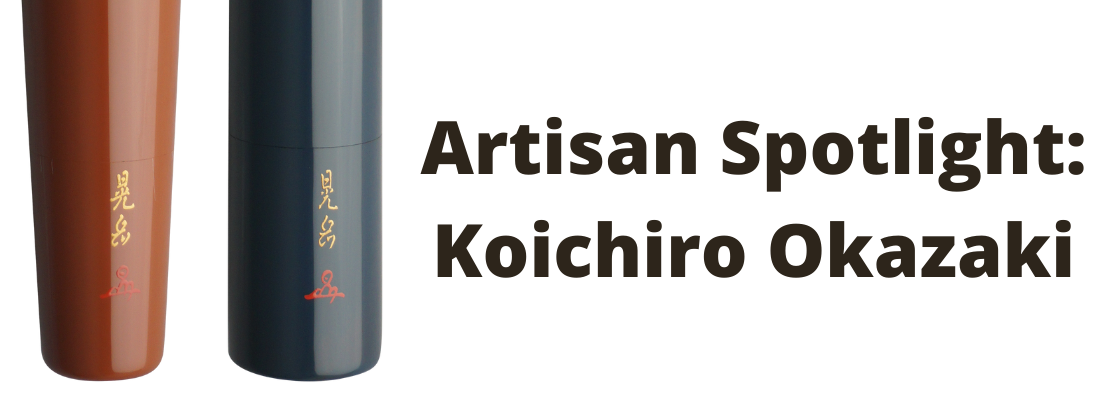Each Danitrio pen is handcrafted by an experienced Japanese artisan, but have you ever wondered about the people behind the pens?
Today we’ll tell you about Koichiro Okazaki, who has crafted many Danitrio pens. (Click here to see all his offerings on UrushiPen.com.)
You could say that urushi runs in Okazaki-san’s blood. He was born in 1959 and comes from a family of urushi artists. His father was a maki-e master.

In his youth, Okazaki-san spent five years apprenticed to an urushi master. Upon completion of his apprenticeship, he became an independent master artisan. He also learned sadō, the Japanese tea ceremony. His schooling grounded him with thorough knowledge of Japanese culture, history, and mythology.
As a master artisan, Okazaki-san paints maki-e on many traditional accessories, watch faces, hair pins, combs, jewelry, and fine writing instruments. Okazaki-san’s artisan signature is ‘Kogaku’. You can see this painted in small characters on each of his pens.
The Japanese government has recognized Okazaki-san as a Dento Kogei-shi, an honorary title meaning “Master of Traditional Crafts.” Only artisans who have made a significant contribution to their craft are given this designation.
Okazaki-san’s maki-e creations have won many awards at national art exhibitions over the years. In short, he is a renowned maki-e artisan and a national treasure.
When Danitrio interviewed Okazaki-san, he said, “An artist must employ the correct techniques at the right times and also constantly think of new design ideas…An artist must always try to innovate, using new ideas and new techniques whenever he or she begins a new piece.”
His Danitrio pens range from the relatively simple Bokashi in Red, to the exquisitely detailed Persian Deer. We’ll describe a few of his pens here.
Okazaki-san is a master of the ishimeji style. This is seen in the pen Ishimeji in Red on Mikado. Ishimeji is a method of urushi application that creates a unique finished texture that almost feels like a rock. Its tiny bumps are created by the application of different sizes of urushi powders.
Okazaki-san’s artistic skills are displayed on Phoenix Bird with Flowers. The graceful curves of the phoenix complement the natural arch of the pen body. As the pen creator, each line must be precisely drawn with little to no room for error. The bright golden maki-e of the phoenix creates a stark contrast to the dark red of the background urushi.
A different sort of artistic talent presents in the pen Biwa Player on Camel. Here, a musician is shown with the biwa, a traditional Japanese stringed instrument. The player sits atop a white camel, while birds frolic in the sky above. The stark white of the camel sets off the dark red urushi beautifully.
Dolphin is created in a completely different style. The dolphins themselves are covered and polished with platinum powder. The ocean waves were made with white and blue urushi, creating the illusion of endless beauty around the pen.
Okazaki-san displays his immense skill with multiple urushi techniques in Peacock. Maki-e is used throughout his creative process. Raden, or the placement of mother-of-pearl, appears in the peacock’s feathers. Ishimeji is also used for the soil beneath the bird, creating a multi-textured feel your fingers will touch again and again.
This esteemed artisan describes part of his creative philosophy when he says, “One should never try to do anything just for one’s own good, without thinking also of the benefit of others. If you work too selfishly, you will distrust yourself. I paint in a relaxed mood and chat happily with my wife, but when I come to an important part of my work, all my nerves go into my fingers, and my brain is empty.”
Okazaki-san lives with his family in Wajima, Ishikawa Prefecture, Japan. His son is studying to become an urushi artisan as he did, to carry on the family tradition.
Okazaki-san has created many pens for Danitrio over the years. You can see these and many more by going to our website.
References
Lyn, Bernard. Maki-e, an Art for the Soul. Win Yuan Enterprise Co., Ltd., 2003.






